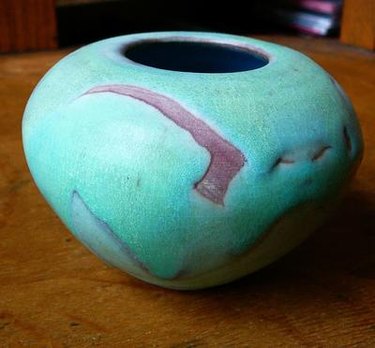Things You'll Need
Two 5-gallon buckets
Protective goggles
Latex gloves
Face mask or respirator
Triple beam scale (capable of measuring as low as grams)
Distilled water
Recipe
Recipe ingredients
Large whisk or emulsion blender
Rubber rib
100-grade sieve
Measuring cups and spoons
Scoops

Glaze is a coating applied to bisque-fired pots that make them watertight and, sometimes, food-safe. According to Lindsey Tomlinson-Peck, owner of The Mudroom Pottery Studio, "Mixing glazes is an exact science and as such, either requires an intense understanding of chemistry in order to make your own glaze recipes, or an ability to follow the instructions of tested glaze recipes exactly." Because glaze mixing requires precise work, she goes on to suggest that "You should always make a test batch of your glaze in the smallest possible portion before using a homemade glaze on one of your real pots."
Step 1
Select a recipe from a reputable source. Recipes are expressed in ratios. To create a test batch, simply convert the ratio numbers to grams to create your glaze. To create a full batch, multiply the ratio by the desired amount. For example, if you wish to make 1,000 grams, then multiply all parts of the recipe by 10.
Video of the Day
Step 2
Measure glaze ingredients individually using a triple-beam scale and mix dry ingredients together in a 5-gallon bucket. It is important to be precise with measurements to ensure that the ingredients will fire at the appropriate temperatures. Any deviance from the recipe could result in an unusable or dangerous glaze that could heat inappropriately and shatter a pot or damage your kiln. Wear goggles, a mask and gloves during the measuring and mixing process as many of these substances are toxic if inhaled.
Step 3
Add 11 oz. of distilled water per pound of dry glaze powder if you are creating a glaze in which you will dip your pottery. Add 8 oz. of water per pound of dry glaze powder if creating a glaze that you will spray on your pottery with a spray bottle. Add 7 oz. of water per pound of dry glaze powder if you are making a glaze you will brush onto your pottery.
Step 4
Mix the dry ingredients with water using a whisk or emulsion blender until the glaze is the consistency of low-fat milk. Set aside for 24 hours.
Step 5
Place a sieve over a clean 5-gallon bucket. Pour the glaze mixture through the sieve into the clean bucket. Push the glaze through the sieve where it thickens using a rubber rib. Clean out the original glaze bucket and repeat the process, transferring the glaze between buckets through the sieve at least two more times until the glaze is completely smooth.
Step 6
Test your glaze on a piece of bisque-fired pottery or an unglazed pottery fragment and fire in a kiln to see how it looks and fires before using it on regular pottery.
Warning
Mixing glazes is a scientific process. Use clean utensils to prevent contamination; wear safety gear to protect your eyes, lungs and skin; and follow the recipe exactly to ensure the correct chemical process takes place.
Video of the Day